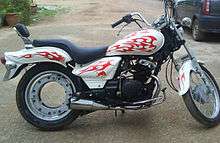Centreless wheel
A centreless wheel (also known as a hubless wheel, spokeless wheel, orbital wheel, or rim-rider) is a wheel with no center.
More specifically, the axle is hollow and follows the wheel at very close tolerances. The hubless wheel was invented by Franco Sbarro (who has built a variety of working hubless wheel vehicles, including at least two motorcycles and a car, the 1989 Sbarro Osmos), and patented by Globeholding of Geneva.
Although hubless wheels are striking in appearance, their numerous practical disadvantages have precluded their widespread use as an alternative to conventional wheels. They are difficult and expensive to manufacture, requiring a great deal of precision machining, and the design leaves the bearings and other critical parts largely exposed to the elements. The drive system is especially problematic since a conventional axle and constant-velocity joint cannot be used; options include using a chain or belt drive.
Examples
Tron: Legacy light cycle
One real-life example of hubless wheels are those used in the replica Tron: Legacy light cycle. The illuminated, street-legal motorcycle was sold through Hammacher Schlemmer, inspired by the computer-animated vehicle from the 2010 film Tron: Legacy. Designed for casual cruising and slow ride-bys at shows, it is made from a steel frame covered by a fiberglass cowling that replicates the sleek look of its computer-generated imagery counterpart.
Electroluminescent wire strips built into the tire cowlings, wheel rims, and body illuminate the cycle. It is powered by a fuel-injected Suzuki 996 cc (60.8 cu in) 4-stroke engine. Riders lie at a near-horizontal position astride the padded leather seat, with feet on foot pegs that control its 6-speed constant-mesh manual transmission and hands on the handlebars for throttle and braking. The hubless wheels are former truck tires built up then custom-shaped to fit onto one of two counter-rotating rims spinning within each other, providing the broad-tired authenticity of the computer cycles from the movie.
Skatecycle
The Skatecycle, invented by Alon Karpman, contains the first hubless wheels to be mass-produced. Its design consists of a double-jointed twisting axle connected to two standing platforms surrounded by 9" polyurethane hubless wheels. In order to move the unit, the rider rotates their feet inwards and outwards, creating a wave-like motion in the hinged frame.
It is the first hubless wheel to employ a practical use for the hollow space as a platform in the center where the user stands (with the wheel giving it the appearance of a stirrup), and in recognition of this, has received the Bronze 2010 IDEA award in the transportation category (as part of this award, the Skatecycle became part of the permanent collection at the Henry Ford Museum).[1]
Zero Bike
Another example of a hubless vehicle is the Zero Bike, a lightweight hubless bicycle whose non-functional prototype won an Industrial Design Excellence Award in 1991.[2] Designed by then-ArtCenter College of Design students Makota Makita and Hiroshi Tsuzaki, it is based on the principle of magnetic superconductivity, also used in high-speed trains that are suspended above rails.
Orbital wheel
The orbital wheel was designed in 1990 by Dominique Mottas of the French Osmos company in an attempt to reduce the number of moving parts by removing the center shaft and hub of the wheel and relying upon a circular or star-shaped framework inside the wheel to support it instead. The orbital wheel was created by using two circular bearings inserted inside of each other. The inner bearing provides steering, support, and attachment to the frame. The outer bearing consists of a tire with a brake ring also fixed in. Some of the advantages seen by this design are more accurate steering, less weight, and enhanced braking.
Hubless wheels in India

In 2011, final-year Mechanical Engineering students Shabin S., Asif Shereef, Abhijith Mohan, and Bibin Salim of P.A. Aziz College of Engineering and Technology in Thiruvananthapuram succeeded in designing and introducing a hubless wheel in a motorcycle as part of their college project. The project, under the guidance of Professor Azeem Hafiz, was completed in four months.
The "Hubless Ryder" was built from a Yamaha Enticer with modifications made to the wheel assembly, swingarm and rear sprocket. The model used a chain-drive system and employed a custom built sprocket. A disc brake was integrated into the rear wheel. The new wheel system is said to have increased steering efficiency, providing a high degree of resistance during tilt.
See also
References
- ↑ http://www.idsa.org/content/panel/idea-2010-transportation-gallery
- ↑ "A Bicycle Far Ahead Of the Pack", New York Times, 29 August 1991